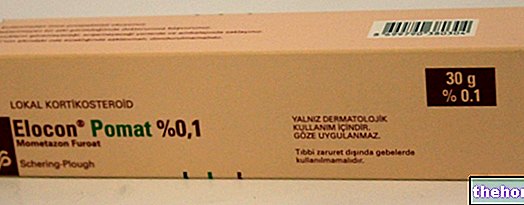CICATRENE ® is a drug based on Neomycin sulphate + Bacitracin zinc + Glycine, Cysteine and Threonine
THERAPEUTIC GROUP: Antibiotics and chemotherapy in combination

Indications CICATRENE ® Neomycin + Bacitracin + Glycine, Cysteine and Threonine
CICATRENE ® is used in the clinical setting in the treatment of superficial skin infections caused by microorganisms sensitive to neomycin and bacitracin or in superficial lesions with infectious risk.
Mechanism of action CICATRENE ® Neomycin + Bacitracin + Glycine, Cysteine and Threonine
CICATRENE ®, a drug widely used both in the clinical setting and as a self-medication tool, is a product capable of combining active ingredients with strong microbicidal activity with amino acids capable of stimulating fibroblastic proliferation by shortening the repair times of the skin lesion.
This activity is facilitated by the possibility of the various topically applied active ingredients to concentrate on site, thus representing a ready-to-use substrate for the various biological elements present.
The therapeutic activity of CICATRENE ® is therefore guaranteed by the presence of:
- Neomycin, an antibiotic belonging to the category of aminoglycosides capable of exerting bacteriostatic and bactericidal action by inhibiting the 30S ribosomal subunit and blocking protein synthesis. The formation of aberrant proteins in addition to compromising the normal metabolic activities of the microorganism, is able to damage the membrane and bacterial wall, causing their lysis.
- Bacitracin, polypeptide antibiotic with direct activity mainly against Gram positive microorganisms capable of inhibiting some enzymatic steps necessary for the synthesis of peptidoglycan, thus compromising the synthesis of the bacterial wall.
- Glycine, Cysteine and Threonine, amino acids particularly used by cells in active replication, essential for fibroblasts in order to optimize the synthesis of the new matrix, thus ensuring rapid recovery of the histological characteristics of the injured tissue.
Studies carried out and clinical efficacy
1. NEOMYCIN IN BURNED PATIENTS
Am J Clin Dermatol. 2002; 3: 529-34.
Topical treatment of pediatric patients with burns: a practical guide.
Palmieri TL, Greenhalgh DG.
Important review demonstrating the efficacy of neomycin taken for topical use in improving the clinical conditions of burn patients, allowing rapid regression of skin lesions and protecting the skin from bacterial infections.
2 . OTOTOXICITY FROM NEOMYCIN
J Laryngol Otol. 2005 Jan; 119: 48-50.
Potential ototoxicity from triamcinolone, neomycin, gramicidin and nystatin (Tri-Adcortyl) cream.
Thomas SP, Buckland JR, Rhys-Williams SR.
Yet another study that demonstrates how neomycin, as an aminoglycoside, has a potential ototoxic role especially in all potentially predisposed patients. For this reason, the application of this antibiotic to the external ear and the ear canal is not recommended.
3. HYPERSENSITIVITY TO NEOMYCIN
Pharmacoepidemiol Drug Saf. 2005 Oct; 14: 725-33.
Contact allergy to neomycin sulfate: results of a multifactorial analysis.
Menezes de Pádua CA, Schnuch A, Lessmann H, Geier J, Pfahlberg A, Uter W.
Interesting epidemiological study conducted on over 47 thousand patients which demonstrates how neomycin can be particularly sensitizing and sometimes responsible for potentially dangerous adverse reactions.
Method of use and dosage
CICATRENE ®
Cream and powder for cutaneous use consisting of 3,300 IU of neomycin sulphate, 250 IU of bacitracin zinc, 10 mg of L-Glycine, 2 mg of L-Cysteine and 1 mg of L-Threonine per gram of product.
It is recommended to apply CICATRENE ® only after thorough cleansing of the injured area.
The application of a thin layer of cream or the appropriate amount of powder twice a day is able to guarantee a speedy wound healing in a few days, avoiding the overlap of bacterial infections.
Warnings CICATRENE ® Neomycin + Bacitracin + Glycine, Cysteine and Threonine
Although the use of CICATRENE ® is generally safe and free from clinically relevant side effects, the prolonged use of the medicine could lead to the onset of local adverse reactions.
The possible appearance of the aforementioned effects should alarm the patient, who, after consulting his doctor, could consider the possibility of suspending the therapy in progress.
The application of the drug on the mucous membranes or on the conjunctiva, on particularly extended regions and on deeply damaged skin could facilitate the systemic absorption of the antibiotics contained therein, exposing the patient to sometimes serious side effects such as nephros and ototoxicity.
Prolonged and inappropriate use of the product could facilitate the formation of strains resistant to common antibiotic therapy, aggravating the patient's clinical picture.
PREGNANCY AND BREASTFEEDING
The use of CICATRENE ® during pregnancy and in the subsequent period of breastfeeding should be carried out exclusively in cases of real necessity and always under strict medical supervision, avoiding all possible conditions capable of facilitating the systemic absorption of the active ingredients.
Interactions
At the moment there are no known active ingredients capable of altering the therapeutic properties and the safety profile of CICATRENE ®.
However, due to the possible nephrotoxic and ototoxic effects, the concomitant administration of other aminoglycosides, especially systemically, is not recommended.
Contraindications CICATRENE ® Neomycin + Bacitracin + Glycine, Cysteine and Threonine
The use of CICATRENE ® is contraindicated in case of hypersensitivity to the active principle and to the relative excipients.
It is also remembered to avoid contact of the drug with the mucous membranes and the conjunctiva.
Undesirable Effects - Side Effects
The use of CICATRENE ® is generally well tolerated and free from clinically relevant side effects.
This safety, guaranteed by the topical intake of the drug and by the low systemic absorption of the active ingredients, does not expose the patient to particularly relevant risks.
However, local hypersensitivity reactions with possible overlap of bacterial infections sustained by microorganisms resistant to neomycin and bacitracin could occur following prolonged use of the drug.
Note
CICATRENE ® is not subject to mandatory medical prescription.
The information on CICATRENE ® Neomycin + Bacitracin + Glycine, Cysteine and Threonine published on this page may be out of date or incomplete. For a correct use of this information, see the Disclaimer and useful information page.




























